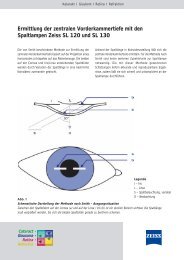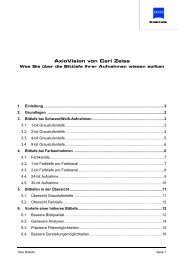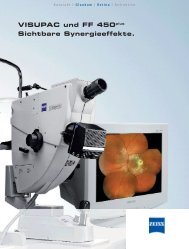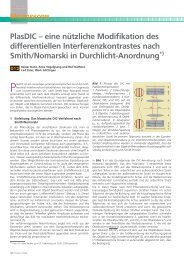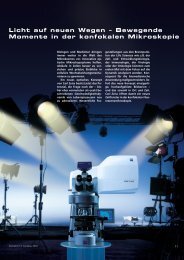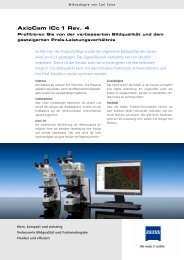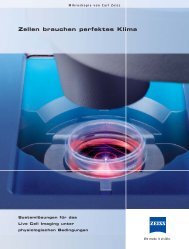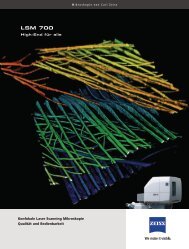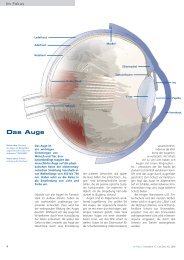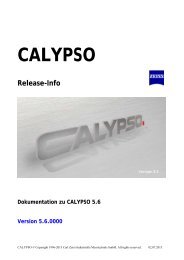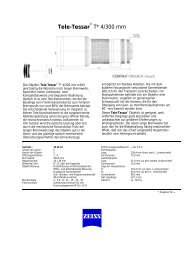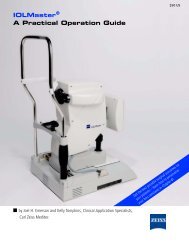FEMTO-LASIK and BEYOND - Carl Zeiss, Inc.
FEMTO-LASIK and BEYOND - Carl Zeiss, Inc.
FEMTO-LASIK and BEYOND - Carl Zeiss, Inc.
You also want an ePaper? Increase the reach of your titles
YUMPU automatically turns print PDFs into web optimized ePapers that Google loves.
June 2012 Supplement<br />
25<br />
Conclusion: Dr Banaji supported that ZEISS had the best<br />
refractive outcome among all topography-guided systems.<br />
He referred to the topography-guided treatment as<br />
“ZEISS’ hidden jewel” <strong>and</strong> called it an “Optical success<br />
for <strong>Carl</strong> <strong>Zeiss</strong>”.<br />
Topography assisted ablation with <strong>Carl</strong> <strong>Zeiss</strong> Meditec MEL 80 <strong>and</strong><br />
CRS-Master (Dr Ruben Lim-Bon-Siong, Philippines)<br />
Dr Ruben Lim Bon Siong on “Topography-<br />
Guided Refractive Surgery: For the Sins of<br />
Our Past <strong>and</strong> Present”<br />
“It is not the end of the road when a<br />
flap complication occurs. There are<br />
topography-guided procedures that<br />
can help these kinds of problems.”<br />
a) Change in Snellen lines of BCVA (N=48)<br />
Topography-guided refractive surgery: Dr Lim Bon<br />
Siong spoke of the topographically customized systems<br />
that aim to correct an irregular corneal surface.<br />
He shared the published results of topography-guided<br />
ablation with MEL 80 <strong>and</strong> CRS-Master by Dan Reinstein.<br />
The results were of 48 eyes in 32 patients who underwent<br />
the procedure for small optic zones, decentered ablations,<br />
decentration after radial keratotomy, high myopia after<br />
deep lamellar keratoplasty, irregular astigmatism due<br />
to wound gape following cataract surgery <strong>and</strong> irregular<br />
astigmatism due to scars. The median follow-up was 7.7<br />
months (1 month to more than 1 year) <strong>and</strong> the mean preop<br />
spherical equivalent was -1.12D ± 1.97D with a mean<br />
preoperative cylinder of -1.34D ± 1.65D. “All patients<br />
had good topographies. <strong>LASIK</strong>, <strong>LASIK</strong>-enhancements,<br />
or PRK were done <strong>and</strong> treatments were centered on the<br />
corneal vertex. “It is a very safe procedure. None of<br />
the patients lost more than 2 lines after the procedure.”<br />
Speaking about the accuracy, he said, “79% of patients<br />
were within +/- 1D <strong>and</strong> 63% within +/- 0.5D. All these<br />
patients had an improvement of least 2 lines or more.<br />
This was very significant compared to the pre-op. It is<br />
very stable. All patients had improved contrast sensitivity.”<br />
Clinical cases: Dr Lim Bon Siong discussed clinical experiences<br />
including cases of a central isl<strong>and</strong>, post-LASEK<br />
corneal scar, lost cap <strong>and</strong> incomplete flap. Additionally,<br />
he discussed a case of a 22-year-old male Filipino who<br />
underwent <strong>LASIK</strong> with XP microkeratome <strong>and</strong> ended in<br />
an incomplete flap with subsequent haze in the left eye.<br />
The preoperative refraction of OS was -3.25-0.50 x 170<br />
(20/20). Three months after the the flap complication, the<br />
UCVA was 20/200 with refraction of +6.50 -2.00 x 170<br />
<strong>and</strong> BCVA 20/30. In this patient a transepithelial PTK was<br />
done with ablation depth of 50µm <strong>and</strong> a diameter of 8mm<br />
b) Accuracy<br />
c) UCVA improvement<br />
d) Stability



